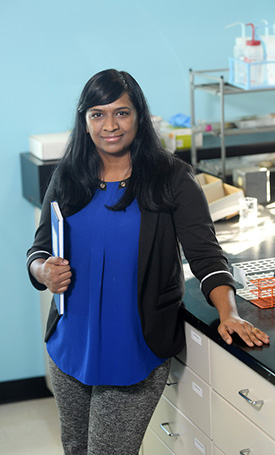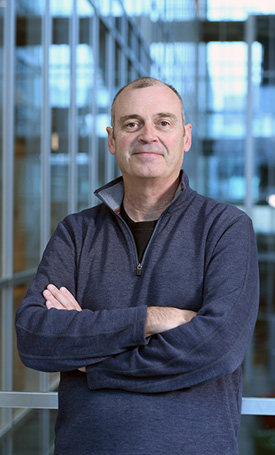Researchers from pilipili┬■╗Ł are collaborating with the National Research Council of Canada (NRC) on a two-year, $500,000 project that could help make Atlantic Canada a hub for green hydrogen innovation.
Drs. Mita Dasog and Michael Freund of the Department of Chemistry are leading the project that aims to identify and test promising catalysts that could serve as alternatives to the costly precious metals used in the production of green hydrogen.
 The bulk of the projectŌĆÖs funding comes from a $352,000 grant awarded through the NRCŌĆÖs (MCF). The MCF program is for and is funded through the NRCŌĆÖs Collaborative Science, Technology and Innovation program. Remaining funding will come from Natural Sciences and Engineering Research Council of Canada and partners.
The bulk of the projectŌĆÖs funding comes from a $352,000 grant awarded through the NRCŌĆÖs (MCF). The MCF program is for and is funded through the NRCŌĆÖs Collaborative Science, Technology and Innovation program. Remaining funding will come from Natural Sciences and Engineering Research Council of Canada and partners.
Shown right: Dr. Mita Dasog.
ŌĆ£Canada and the Province of Nova Scotia have identified green hydrogen to play a crucial role in meeting net zero goals,ŌĆØ says Dr. Dasog, an associate professor and Izaak Walton Killam Memorial Chair. ŌĆ£Hydrogen burns cleanly to produce thermal energy and/or electricity. It has the potential to decarbonize hard-to-abate sectors such as material and chemical manufacturing industries, heavy-duty transport, shipping, and aviation.ŌĆØ
Producing green hydrogen
Commercially, green hydrogen is produced using a process called water electrolysis, in which an electrolyzer ŌĆö powered by a renewable energy source such as wind or solar ŌĆö splits fresh water into hydrogen and oxygen. Unlike other methods of producing hydrogen, which can involve the use of natural gas, coal, or non-renewable energy, green hydrogen does not result in any greenhouse gas emissions. A hindrance to more widespread use is that commercial proton exchange membrane (PEM) electrolyzers require precious metals as catalyst materials on its anode (iridium) and cathode (platinum).
For green hydrogen production to ramp up, itŌĆÖs necessary to replace precious metals with something cheaper and more readily available. ŌĆ£If we replace the current metals with other high-performing elements that are also rare, like palladium or rhodium, itŌĆÖs still the same problem,ŌĆØ says Dr. Dasog, the principal investigator on the project. ŌĆ£Our focus is to start replacing precious metals with more abundant elements, but they have to perform as well as current catalysts do.ŌĆØ
Identifying alternative catalysts
Fortunately, there is no shortage of scientific literature discussing catalysts in green hydrogen production, but reading through thousands of research papers is not a task that can realistically be done individually. Enter artificial intelligence (AI).╠²
 The first step in the project involves developing a Chat GPT-like tool capable of reading human language that will comb through existing research papers and identify potential catalysts free of precious metals that meet certain performance metrics. Dr. Dasog says she and Dr. Freund will collaborate with Dr. Frank Rudzicz, an associate professor in the Faculty of Computer Science, and the NRC teams to develop this tool.╠²
The first step in the project involves developing a Chat GPT-like tool capable of reading human language that will comb through existing research papers and identify potential catalysts free of precious metals that meet certain performance metrics. Dr. Dasog says she and Dr. Freund will collaborate with Dr. Frank Rudzicz, an associate professor in the Faculty of Computer Science, and the NRC teams to develop this tool.╠²
Shown left: Dr. Michael Freund.
Step two heads back to Dr. DasogŌĆÖs lab where the catalysts shortlisted by the AI-tool will be made in-house. ŌĆ£The literature will provide the recipe to make these,ŌĆØ she says.╠²
The third step is benchmarking. ŌĆ£Once we have made the materials, the Freund lab will test them all under the same conditions, benchmarking protocols that the NRC has developed and are used by other international labs,ŌĆØ Dr. Dasog explains. ŌĆ£This will give us a more realistic evaluation of how promising these materials are and whether they have a chance of replacing precious metals in electrolyzer components.ŌĆØ
Another key consideration in this stage is making sure these replacements are resilient to water quality. ŌĆ£Current electrolyzers require a certain water-quality standard to operate,ŌĆØ says Dr. Dasog. ŌĆ£Having an expensive catalyst and needing to spend so much energy purifying water is one of the few reasons why green hydrogen is not as cost competitive as grey hydrogen. The hope is that if the catalysts are water resilient, that will bring down the cost of green hydrogen.ŌĆØ
Finally, step four involves testing the most promising catalysts in realistic water conditions with the help of an industry partner, in Newfoundland. Catalysts that pilipili┬■╗Łfully pass the tests will be shipped off to the NRC for further analysis beyond whatŌĆÖs capable at Dal.
Planning a greener future
Dr. Dasog hopes that the project will result in advancement towards making next generation electrolyzers that are cheaper and water-quality resilient. ŌĆ£Given the local interest in green hydrogen, it is also important that we create a path to manufacture electrolyzers without significant backlogs,ŌĆØ she says. ŌĆ£Moving away from precious metals will help mitigate some of the challenges associated with their supply-chain.ŌĆØ ╠² ╠²
ŌĆ£Everyone wants to produce green hydrogen cheaply,ŌĆØ she adds, and proving that it is possible to lower the cost of electrolyzers by lessening their dependence on rare materials should help increase the Atlantic regionŌĆÖs adoption of green hydrogen. The NRCŌĆÖs hydrogen research has primarily taken place in Ontario and British Columbia, so the project also provides a chance to train graduate students and other highly qualified personnel from the Atlantic provinces. This project will help strengthen the collaborations between Dalhousie and NRC labs and build a path toward future opportunities to advance green-hydrogen technologies.╠²

